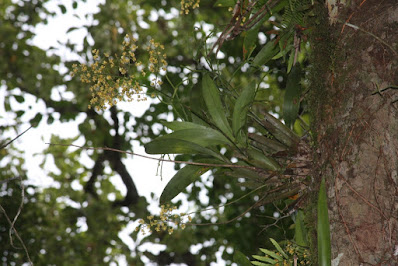The Scoop Oncidium is native to Brazil. The plant is found both on the plains and in the colder mountains in the states of Espírito Santo, Rio de Janeiro, Sao Paulo, Paraná, Santa Catarina and probably Rio Grande do Sul at elevations of 200 to 700 meters.
Oncidium venustum orchid, also called as The Scoop Oncidium, Baptistonia venusta, Campaccia venusta, Carenidium venustum, Gomesa venusta, Oncidium dimorphum, Oncidium galeatum, Oncidium ornithocephaloides, Oncidium trulliferum, is a species of the genus Oncidium. This species was first described by Drapiez in 1836.
IDENTIFY ONCIDIUM VENUSTUM ORCHID
The Scoop Oncidium is native to Brazil. The plant is found both on the plains and in the colder mountains in the states of Espírito Santo, Rio de Janeiro, Sao Paulo, Paraná, Santa Catarina and probably Rio Grande do Sul at elevations of 200 to 700 meters.
This plant is a medium sized, warm to cool growing orchid with 38 cm high. It has curved 'S' shaped columns and an elongated anther and rostellum forming a beak like appendage at the apex of the column. This species unlike the other two produces large sprays of graceful flowers on a semi arched inflorescence and can have up to 100 flowers on 4 to 10 branches with 4 to 12 flowers on each one. This orchid is characterized by having oblong, compressed pseudobulbs (10-21 cm long and 2.5 cm wide) carrying 2 to 3 leaves (lengths 15-23 cm and width 2.5-5 cm).
It blooms in the summer and fall on a paniculate, 2' (60 cm) long, many flowered inflorescence. The permanent flowers have a diameter of 2.5 cm, the petals are light to greenish-yellow, have red-brown stripes, the lip is in the front part red; the thickening is also red.
GROW AND CARE ONCIDIUM VENUSTUM ORCHID
Cultural information should only be used as a guide, and should be to be adapted to suit you. Your physical location; where you grow your plants, how much time you have to devote to their care, and many other factors, will need to be taken into account. Only then can you decide on the cultural methods that best suit you and your plants.
Light:
Oncidium venustum orchid need a light source of 20000-30000 lux. That plants adapt to both indirect light and semi-shade. It seems, however, that direct sunlight should be avoided. Strong air movement should be ensured all the time.
Temperature:
In summer, the average day temperature is 24-26 ° C, at night 17-18 ° C , with an amplitude daily 7-9 ° C . In winter the average day temperature should be 19 ° C , and the average night 12 ° C , with an amplitude variation during day approx. 7-8 ° C. Due to the large range and height of the habitat above sea level, plants should adapt to warmer conditions by 4-6 ° C than indicated.
Humidity:
The plant needs 80-85% of humidity for most of the year, with a drop to 70-75% in winter.
Substrate and growing medium:
The most beneficial for the plant is cultivation on cork or tree fern flakes or planting in small pots filled with a highly permeable substrate. They can be tightly attached to pieces of cork or fern. That plants grow well in small containers filled with a well-permeable substrate. The substrate should be coarse and permeable to allow the roots to dry quickly after watering, pieces of tree fern or bark is recommend.
Watering:
Cultivated plants should be watered abundantly, more often from late summer to autumn, much less from late autumn to late spring, use a substrate with high permeability to allow it to dry quickly and not allow it to become stale or soaked.
In winter, plants in cultivation should definitely reduce watering, but it can not be allowed to completely desiccate for a long time. Plants grown in colder conditions should be supplied with less water than those grown at higher temperatures.
Fertilizer:
During the active growth of the plants should be fertilized every week 1/4-1/2 of the recommended dose of fertilizer for orchids. Fertilization should be reduced or eliminated until new growths appear and a more abundant spring watering begins.
Rest period and repotting:
Plants hate rotting in the vicinity of the roots, so the substrate should be replaced before it goes down. It's best to do it, when new roots start growing. This allows plants to root in the shortest time, which minimizes stress.















COMMENTS